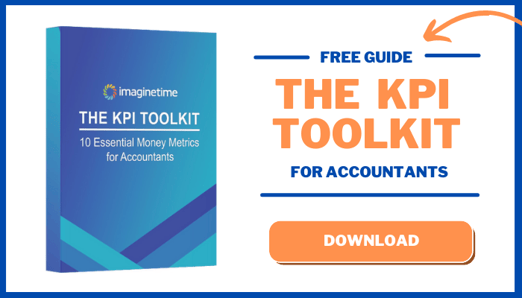“What gets measured gets done.” Variations on this little management cliché have made the rounds for decades, and for good reason. Measuring the right data is key to making sound strategic decisions and running a more efficient, profitable company.
Without good data -- and easy ways to view and contextualize it -- leaders have no way of telling how the business is actually performing. This is true not only for large multinational corporations but for your accounting firm as well.
Key Performance Indicators, or KPIs, are metrics that indicate how an organization is progressing towards its most important goals. For most accounting firms, the end goal is efficient operations and healthy profits. So instead of tracking every possible metric and report under the sun, we need a list of the KPIs that will make the biggest impact on your efficiency and profits.
Later in this article, I will share the 5 under-used metrics every accounting firm should be tracking each month to run a leaner, more profitable company. And at the end of the article, I have a link for you to download The KPI Toolkit - 10 Essential Money Metrics for Accountants.
But first, let’s take a look at what good Key Performance Indicators have in common.
- Easy to Calculate: KPIs should be able to be produced quickly so that management can make timely decisions. If KPI calculations are manual and tedious to pull together, leadership may miss out on the ability to lean into strategies that are working or pivot to new opportunities that will work better.
- Easy to Visualize: It should not take a rocket scientist to decipher KPIs. Simple graphical representations of metrics will help management make key decisions. While the underlying data may be robust, less is more when it comes to the end presentation.
- Easy to Compare: KPIs can be easily calculated and visualize, but firm leadership also needs to know how the KPIs compare to other benchmarks. Common comparison points are prior month, prior year, budget, prior forecasts and industry averages.
5 Essential KPIs for Accounting Firms
This list of five essential KPIs for your firm will not include metrics like “net profit” or “sales growth”. I’m going to assume you’re already tracking those. Instead, this list includes a few metrics that most people don’t track but could make all the difference in your long-term profitability.
Revenue and Profitability Key Performance Indicators
1. Write Up and Write Down Rate
Which clients are causing the most write ups or write downs?
Chances are that your firm has standard bill rates that are charged based on the type of work being performed and the level of employee performing the work. For example, you may bill a client $60 per hour for work performed by an entry level accountant, $90 per hour for a senior accountant, and so on.
For fixed price contracts, there will almost always be a difference between the weighted standard billing rate and the actual billing rate, which is calculated as: total billed amount to client divided by total hours worked on engagement. When the calculated actual billing rate exceeds the standard billing rate, a write up has occurred. When the opposite happens, a write-down has occurred.
There can be many reasons for the difference between standard and billed rate, such as unexpected time-consuming challenges and adding extra work to impress the client. No matter what the reason, it is important for firm leadership to have visibility into which clients are causing write ups and write downs. What you do with this information is up to you, but not knowing it should not be an option.
2. Accounts Receivable Aging
Which clients are late paying, and by how much? What’s the likelihood I’ll actually receive payment?
For every business in existence, cash is king. Without healthy cash flow, organizations risk losing flexibility when it comes to taking on new opportunities, or worse case, not being able to pay bills and potentially shut down shop.
For accounting firms, revenue from clients is obviously the main source of revenue. Like many professional service organizations, contracts are sometimes paid after the work is completed.
An accounts receivable aging report indicates how much is owed by each client and how long the balance has been outstanding. If there are clients whose balance is aged greater than your firm’s standard payment terms, it may indicate a risk that the client will not pay. A simple aging report will let management know which clients to press on payments and potentially which ones to avoid for future work.
At this point, it is important to note that you can (and should) be pursuing “A/R Zero.” A/R Zero is the idea that with right billing software and workflow, you can fully eliminate accounts receivable. Instead of billing and waiting for payment, this process allows you to send an invoice and then automatically charge your client’s card after a set period of time (we recommend 7 days). Not only does this eliminate the need for an AR Aging report, it also significantly increases collection rates.
3. Realization Rate
Who really are my most profitable clients and employees?
Realization rate is another metric used to calculate client profitability. Realization rate compares the actual amount invoiced to the client to the chargeable time spent working on the engagement.
As a simple example, assume a senior accountant with a billable rate of $100 works on an annual compilation for a client. The client has been with the firm for many years, and the firm continues to bill them $400 each year for the engagement. This year, the senior accountant spends six hours (or $600 of chargeable time) completing the engagement. In this example, the realization rate is 67% ($400 divided by $600).
It is important for firm leadership to have access to realization rate reporting. Low realization rates indicate that firm personnel are not properly deployed on projects that translate to maximized revenue.
4. Work in Progress
How are we doing on our current projects? Are we in line with the time and resource expectations we had at the beginning of these projects or does something need to change?
At any given time, your firm has many engagements in progress at various stages of completion. And during tax season, your client workload may seem like the Wild West. It is important for firm management to be able to see how they are doing “to date” on each engagement. Work in Progress is measured by comparing billable hours to date to total hours budgeted for the engagement.
A good work in progress report will give leadership a birds-eye view of how billings to date compare to the budget and resources that are needed to complete each open job. Red flags can be easily identified. From there, management can strategize how to deploy their staff to maximize realization. In some cases, management can renegotiate contracts with clients if warranted. The Work in Progress report gives leadership the ability to take these actions.
Scale and Efficiency Key Performance Indicators
5. Utilization Rate
How much of my team’s time is spent doing billable work?
Utilization rate is a metric defined as the percentage of an employee’s total time spent that is actually billable to the client. As an example, a senior auditor worked 40 total hours last week. They spent 24 billable hours working on an audit for a large client. They also spent 16 hours at a two-day continuing education conference. Their utilization rate for the week was 60% (24 billable hours divided by 40 total hours worked).
Utilization rate measurement is directly correlated to time tracking data. There needs to be a good time tracking system in place so that chargeable and non-chargeable time can be properly broken out.
It should be noted that high utilization rates are not always good. As an example, suppose a staff auditor spent all 40 hours last week working on one audit client’s engagement and their utilization rate was 100%. Sounds like a real go-getter, right? Well, the client is on a fixed contract and the firm can only invoice the client the equivalent of 30 hours of chargeable time. This sinks the realization rate and shows how these key performance indicators can work together to give you a full picture of what is actually happening in your firm.
Simple yet informative utilization rate reporting will serve as another useful tool for managers to have at their disposal to weigh important staffing and billing decisions.
The Secret to Running a Better Firm
The secret to running a better firm is to track the right data, make it easy to visualize and make smarter decisions. It really is as easy as that.
The problem most firms run into is that they either don’t track employee time accurately or their data is in so many different places that it’s nearly impossible to run meaningful reports.
That is why a good accounting practice management software is so important if you’re really wanting to grow. It allows you to easily access the data you need about your employees and clients and then put it into easy-to-visualize reports that give insight into every element of your business.
Regardless of how you generate your monthly reports, these 5 under-used metrics will give you a more accurate picture of what is really going on in your firm.
To get an even clearer picture of your practice, download The KPI Toolkit - 10 Essential Money Metrics for Accountants.
.png?width=150&height=63&name=TWRlogo-regmark_blueblack%20(1).png)
.png)











Do you have questions about this article? Email us and let us know > info@woodard.com
Comments: